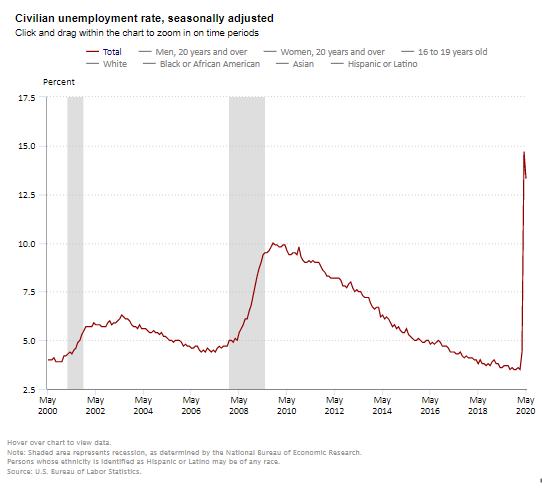The Labor Department reported that jobs rose by 2.5 million in May, while the jobless rate fell to 13.3%, a surprising outcome given the severity of pandemic-related lockdowns on the economy and other recent less bullish measures of economic performance. The increase in May followed a loss in jobs of 20.7 million in April, which was the largest decline in records dating back to 1939. Analysts had predicted an increase in the employment rate to 19% and a decline of 7.5 million jobs in payrolls.

The May unemployment rate was down 1.4 percentage points from 14.7% in April to 13.3% in May. As recently as February it was at a 50-year low of 3.5%. During the 2008/2009 recession, the unemployment rate peaked at 10%.
The underemployment rate or the U-6 jobless rate slipped back to 21.2% from 22.8% in April.
This figure includes those who have quit looking for a job because they are discouraged about their prospects and people working part-time but desiring a full work week. In the previous 2008/2009 recession, this rate peaked at 17.2%.
In the BLS report, the following comment was provided to explain the surprising drop in jobless number: “If the workers who were recorded as employed but absent from work due to "other reasons" (over and above the number absent for other reasons in a typical May) had been classified as unemployed on temporary layoff, the overall unemployment rate would have been about 3 percentage points higher than reported (on a not seasonally adjusted basis). However, according to usual practice, the data from the household survey are accepted as recorded. To maintain data integrity, no ad hoc actions are taken to reclassify survey responses.”
Revisions also subtracted thousands of jobs in the prior two months. The change in total nonfarm payroll employment for March was revised down by 492,000 from a loss of 881,000 to a loss of 1.4 million and the change for April was revised down by 150,000 from a loss of 20.5 million to a loss of 20.7 million. With these revisions, employment in March and April combined was 642,000 less than previously reported. Monthly revisions result from additional reports received from businesses and government agencies since the last published estimates and from the recalculation of seasonal factors.

Average hourly earnings for all employees on private nonfarm payrolls rose in May fell by 29 cents to $29.75 but was up 6.7% from year-earlier levels.
The labor force participation rate, which is a measure of the share of working age people who are employed or looking for work edged up by 0.6 percentage point to 60.8%. Total employment, as measured by the household survey rose by 3.8 million in May to 137.2 million, following a large decline in April.
Separately, the Labor Department reported yesterday that initial claims for unemployment insurance totaled 1.9 million jobs in the week ending May 30. Continuing claims, a measure of ongoing unemployment reported with a one-week lag increased to 21.5 million. Also the Federal Reserve’s Beige Book showed economic activity continuing to deteriorate even in regions that started to remove lockdown measures at the end of April and the beginning of May, suggesting a rebound in jobs will still be limited.
Today’s report was much stronger than expected and is welcome news because it could indicate that the labor market is starting to stabilize. However, while some businesses may gradually return to “normal”, not every sector will recover at the same pace. In the meanwhile, and tragically, millions of people are suffering from illnesses, anxieties and deaths associated with the pandemic and from the human tragedies associated with of the collapse in the national and global economies.
About Beth Mace
Beth Burnham Mace is a special advisor to the National Investment Center for Seniors Housing & Care (NIC) focused exclusively on monitoring and reporting changes in capital markets impacting senior housing and care investments and operations. Mace served as Chief Economist and Director of Research and Analytics during her nine-year tenure on NIC’s leadership team. Before joining the NIC staff in 2014, Mace served on the NIC Board of Directors and chaired its Research Committee. She was also a director at AEW Capital Management and worked in the AEW Research Group for 17 years. Prior to joining AEW, Mace spent 10 years at Standard & Poor’s DRI/McGraw-Hill as director of its Regional Information Service. She also worked as a regional economist at Crocker Bank, and for the National Commission on Air Quality, the Brookings Institution, and Boston Edison. Mace is currently a member of the Institutional Real Estate Americas Editorial Advisory Board. In 2020, Mace was inducted into the McKnight’s Women of Distinction Hall of Honor. In 2014, she was appointed a fellow at the Homer Hoyt Institute and was awarded the title of a “Woman of Influence” in commercial real estate by Real Estate Forum Magazine and Globe Street. Mace earned an undergraduate degree from Mount Holyoke College and a master’s degree from the University of California. She also earned a Certified Business Economist™ designation from the National Association of Business Economists.
Connect with Beth Mace
Read More by Beth Mace